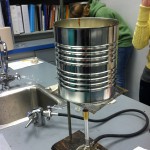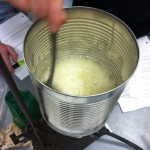This post is dedicated to special education professionals everywhere, with my apologies that you have to work with science teachers.
Many students in special education have IEP’s specifying a reduced work load. This specification was perhaps meant to minimize the frustration from an overwhelming number of practice math problems or with essays of unmanageable length. Doing ‘every other question’ isn’t practical when the task is a laboratory investigation.
To better help students learn scientific investigation, I started to focus on just one significant part of the actual investigation and report at a time. Here are the components of the lab write-up:
- Experimental Question – what you want to know and can find out with an experimental design
- Hypothesis – possible answer to question; testable, potentially falsifiable
- Introduction – background information needed about the topic to be investigated
- Materials (written as the investigation is designed)
- Procedure – written in short steps as a set of directions. Include everything on the Score Sheet list, linked below.
- Safety – apparel, MSDS info on any chemicals used, equipment cautions.
- Data table
- Data analysis – includes graph or other alternative representation of data, and discussion of hypothesis as supported or not
- Calculations and calculations table – calculations done in format of describing what is to be calculated, an equation, and a sample of the math.
- Conclusion – answer the experimental question, use data to support your answer ( numbers! use high and low average of 3+ trials) and explain how the data answers your question.
Now if this looks suspiciously like the standard for investigations in some state’s standards, I will agree. Students must write in this format to receive a high score on the high-stakes test. It’s also not bad science, overall, so we just do it.
How to do half of this? We start the year with a lab activity to which pretty much everyone knows the answer: How does exercise affect your heart rate? We walk together through all the parts and everyone writes each component into his or her lab book during class, working in groups, over 4 days. During this time, we talk together about the variables that might affect heart rate, such as the type and speed of exercise and what variables we can keep the same, or control, for everyone. We also talk about what we can’t control, such as the food eaten for breakfast, body size, leg length. We decide on an experimental control as a student who does not exercise at all yet whose heart rate we record at the beginning and end of the exercise time, with everyone else’s.
Examples of the student handout for our Photosynthesis lab, with directions for the introduction and data analysis are here. The score sheet checklist is here. I copy the documents back to back and hand to students as we begin the lab write-up. It;s the 5th investigation we do, so most are pretty good at it. Help yourself; I’d love your feedback. I know the score sheet is labeled “rubric” when it is really more of a student checklist, but it’s progress….
The focus for this lab is the design, or procedure, itself. Options for students needing a reduced assignment include:
- writing the hypothesis to a given experimental question
- reviewing the introduction material with teacher or lab group and writing a statement telling the purpose of the lab
- safety must be written by everyone, period
- writing the procedure and materials together with the lab group.
- directions on how to re-work the data, or interpretation of a ready-made graph of the data
- analysis questions are easy: select depending on the student’s needs and focus. Perhaps the student is already good at identifying variables, so select other questions. Perhaps the student needs to learn to identify variables, so select the variable questions and one other.
- the conclusion is pretty basic – if the student has had guidance with the data, the conclusion is surprisingly easy.
Maybe this isn’t exactly half a lab. It’s a ‘reduced assignment,’ though. It’s been my experience that even struggling students will accept this version if given guidance and the security net of a lab group at first. Can they go through life with a security net? Probably not. This one is just a step in the direction of self-sufficiency and using one’s resources. We don’t all walk that direction at the same pace.
Like this:
Like Loading...



 Oregon requires students to complete an inquiry work sample (
Oregon requires students to complete an inquiry work sample (
